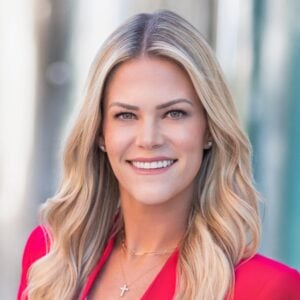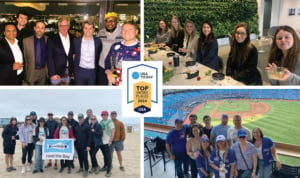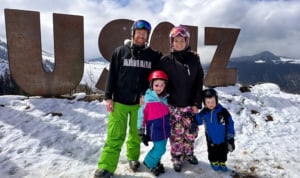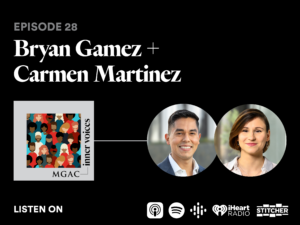MGAC Impacts: Elyse Roeder on Reimagining Schools, Empowering Women, and Leading by Example

The Impact Blog is a spotlight series that highlights and celebrates the diverse employees that make MGAC tick. Beyond their day-to-day schedules, we want to know how they have a greater impact on their colleagues, their company, and the communities in which they live and work. We want to know what makes them get out of bed in the morning, what led them to their current role, and what they hope their lasting impact will be.
Today, we get to know Elyse Roeder, Vice President at MGAC.
—
MGAC: Hi Elyse! It’s great to have you on the Impact Blog.
Elyse Roeder (ER): Thanks, it’s great to be here.
MGAC: Tell us about your role at MGAC.
ER: I am a Vice President and I manage a team of project managers and cost consultants. We work for the District of Columbia Department of General Services on two programs: DC Public Schools (DCPS) modernization, and DC Parks and Recreation (DPR) modernization and renovation. We have two project managers on parks and seven on schools.
MGAC: Very nice! What does your work on these projects look like?
ER: DCPS puts out five to ten schools every year, and they’re very fast-paced projects—typically entailing a year of design, and two years of construction. With schools, there’s a huge community impact, and we always take part in an engagement project called the School Improvement Team. This is a group of administrators, community members, parents, and faculty who get to be advisors to the project and weigh in on what’s important to the community—playground spaces; outdoor spaces; whether afterschool programs, or other community groups will utilize the space; and so on. We meet with them at various milestones to present our designs, and they actually help us choose a concept.
MGAC: What a cool way to get the community involved.
ER: Definitely. Some communities are super engaged, with tons of people showing up to give you their opinions, while others have little to no parent involvement at all, so it’s more focused on the administration. It’s fascinating to see the different types of people who weigh in and the things that end up being super important to them.
MGAC: No doubt that variety keeps things interesting!
ER: It really does. Another interesting thing about DC is its public art budget. Designers will designate certain areas of buildings for murals, sculptures, and the like, so when we’re working on a school, we get to hire a local artist to come in and contribute something special. It’s always such an exciting thing to see—what kind of local art comes in, and how it’s a reflection of that community.
MGAC: What are some main priorities when it comes to school modernization?
ER: We’re working to make all DC schools Net-Zero Energy, which is pretty exciting. We turned over the first one two summers ago: John Lewis Elementary School, which was a ground-up project. We have another Net-Zero school underway now, a renovation to Raymond Elementary, which was built in 1924, as well as a parks project, Stead Park. After 2026, everything designed by the District will have to be built to this standard, so the schools and parks are trying to get ahead of that now. On several projects, you’ll find that the site constraints, historic nature, or other elements pose some unique challenges to sustainable building. Our job is to help the District find solutions.
MGAC: Let’s back up a bit. What were you doing prior to joining MGAC?
ER: I spent 15 years as a general contractor for Clark Construction. We worked on some of the coolest mega projects in the District—the Wharf, the U.S. Coast Guard Headquarters, all over $300M developments. But I was looking to utilize my skills on the owner’s side. You see so many gaps when you’re working with a client: maybe they don’t really know what they want, or they need guidance on schedules or the impact of certain decisions. These were areas where I really excelled in the general contracting space, so I wanted to put those skills to use in a new way.
MGAC: Was this kind of work always on your radar?
ER: I don’t remember what I wanted to do as a kid, but high school was when I really discovered an affinity for math and science—physics in particular. For a time, I thought I might pursue that, but my mom encouraged me to try engineering—something a bit more application-based. There was this really beautiful bridge in Boston (I grew up a couple hours away, in Northampton) called the Zakim Bridge. I got it in my head that I wanted to build bridges like that, not realizing that the beautiful parts are mostly designed by architects. I toyed with becoming an architect for a minute, but I’ve never been a very artsy person. When Clark Construction came to my college looking for interns, I thought general contracting sounded up my alley, which is how I ended up where I did.
MGAC: What do you think your teenage self would think of your current job?
ER: When I think of myself back then, I think I really just wanted to be “the boss”—to be in charge of people and the way things go. That’s basically what I am now! I manage a group of people, a project, a process. I keep things moving forward.
MGAC: Very full circle! Speaking of moving things forward, what projects are keeping you busy these days?
ER: I’m currently working on two schools—School Without Walls at Francis Stevens, which is a $90M renovation and addition project in the West End. The cool thing about that one is that it backs up to Rock Creek Park. We’re working with the National Parks Service to create a space that really works for the school and the community. I’m also working on a renovation of Browne Education Campus. It’s a very large school, tracking at $90M.
MGAC: Sounds like a full plate! When you think about your role at MGAC, what do you hope your lasting impact is here?
ER: One of my favorite things about my current role is that I get to mentor a lot of people. So many of us have experienced feeling like you can’t speak up in a meeting or can’t comment on something due to impostor syndrome. I love empowering my people to go out and solve problems or get the answers they need. I always say, “I’m here to support you if you totally fail, but you’re not going to!” This is where you really start to see people blossom and take on a true leadership role themselves. So that’s the impact I’d like to make, especially among the young women I work with. The impostor syndrome can often feel doubled for them.
MGAC: A common experience in male-dominated industries.
ER: It’s true. We’re often the only women in a room full of people. I like being an example, for my mentees, of someone who has progressed further in her career, who has two children, and can still manage as both a mom and a leader. I’ve worked mostly for men my whole career, but the first female direct boss I ever had was at MGAC. It can make a real difference to have someone who really understands the issues you’re facing in that role.
MGAC: Absolutely! What have some of those challenges looked like for you?
ER: I think the greatest challenge I’ve faced is being underestimated when people first start working with me—getting them to see my experience and capability right off the bat and building the necessary trust for a good working relationship. For the most part, I’ve almost never walked into a room and had everyone immediately see me as the subject matter expert that I am. It feels like there’s always someone questioning, “Who is this woman, and why is she bossing us around?”
MGAC: What are some of the biggest lessons you’ve taken from these experiences?
ER: That everybody has something to bring to the table and deserves the opportunity to share their opinion. It’s all about taking a moment to listen, even if someone just started yesterday. Maybe their question does more than just help them understand something; maybe it presents a groundbreaking idea, or a perspective we’ve never considered before.
MGAC: Your work is deeply connected to the DC area and its residents. How do you hope your work will impact the community at large?
ER: It’s very cool to see teachers and students going from a building where it’s like, “Yeah, this is acceptable, we can do our math here,” to a space that actually influences how they learn. When we complete a super sustainable school project, there’s often a new curriculum on sustainable building and how it works. It gets the kids inspired to learn about architecture, engineering, etc.
MGAC: Talk about leaving a positive impact on the next generation!
ER: Right? If I had that kind of opportunity as a kid, maybe I would have picked up on what I was supposed to be doing a lot sooner!
MGAC: It’s very cool how you’re able to positively influence the lives of others through your work every day. Since you came on board, in what ways has MGAC made an impact on you?
ER: MGAC is ready to support you in any new initiative. We’re a great size: not so large that there’s red tape involved in implementing a great idea, but big enough to have plenty of resources at our fingertips. If you need a person on your team with certain certifications, you can designate someone to go out and get them. MGAC is more than happy to support that. They give you all you need to be more effective for your clients.
MGAC: That’s great to hear. What have you found most rewarding about your job?
ER: Getting to see the end users enjoying their new space. We get to go in and make real, significant improvements in places that weren’t really working for them in the past. We’re not just fixing a hole in the floor or something. We’re making an entirely new space that’s more conducive to learning and play, and how the modern child goes to school.
MGAC: Time for a few rapid-fire questions. What gives you energy every day?
ER: I really like to plan and execute, which I think is why I’m so good at my job! Making a plan, changing the plan, and watching things come together—it all makes me happy.
MGAC: How do you wind down at the end of a long day?
ER: I have two little girls who are four and six years old, so every evening, we’ll do our nightly routine: take a bath, read a book together, snuggle a little bit, and say goodnight. So that’s really how I unwind, too.
MGAC: What do mornings look like for you?
ER: I get up and start getting the kids ready and out the door, which is usually a very hectic timeframe—they listen a lot less than my team members!
MGAC: What’s the first thing you do at work every day?
ER: I’m a list person—I love checking things off. Again, it’s all about the plan! Each morning I come up with my priority list and check that I haven’t overscheduled myself. I also make a list of things my team should be doing, and make sure I’m checking in on those.
MGAC: What’s the most interesting thing we might find in your desk or work bag?
ER: Lots of random children’s things! Dolls seem to find their way into my bag, hair clips… and I’m constantly finding things in my pockets that fell on the floor the day before.
MGAC: What’s your go-to weekday lunch?
ER: This winter, I’ve been on a big soup kick, and trying lots of new recipes. I made minestrone last week, which was great. As it gets warmer though, it may become salad season.
MGAC: What’s the most used app on your phone?
ER: Outlook.
MGAC: Describe your job in five words or less.
ER: Planning. Questioning. Pushing.
MGAC: What’s your biggest work goal for 2023?
ER: My main goal is making sure my people are developing and hitting their own career goals, as far as getting to the next level, or getting the resources they need to support our clients.
MGAC: What’s something your colleagues don’t know about you?
ER: I’m a bit of an oversharer, so most people who spend any time talking to me know a lot! But some of my favorite hobbies outside of work are camping and hiking. I love going out with my husband and my kids, so we plan several trips in the summer to get outdoors and connect.
MGAC: Cool! Any favorite spots?
ER: We go to Shenandoah River State Park, which is about an hour and a half from where we live in Virginia. It’s right on the river, and tubing there is a lot of fun.








